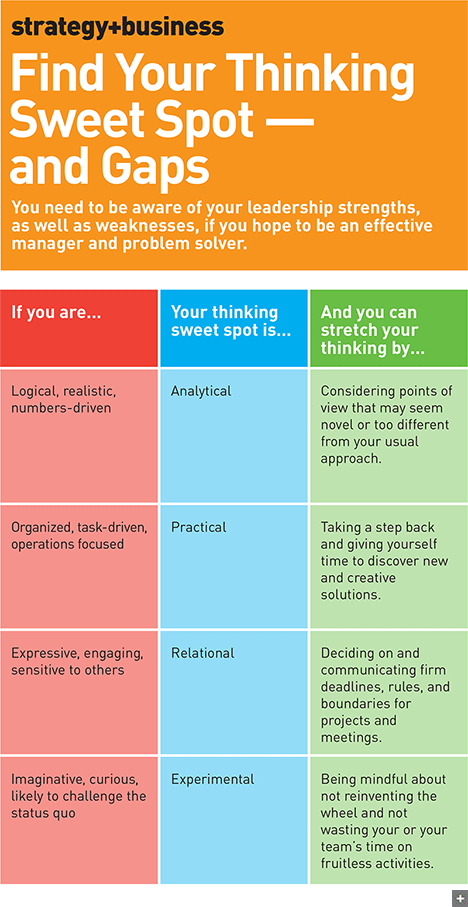How Leaders Can Improve Their Thinking Agility
Leaders operate with near-constant deficits of time, energy, resources, and focus, which keeps them locked in a perpetual state of catch-up. This reality erodes quality contemplation. Although there are strategies to help you react to the urgencies of the day without sacrificing time to reflect, the value and impact of your thoughts are not simply a measure of minutes. Rather, they can be measured by the thinking agility you apply to changing priorities and circumstances.
More specifically, your capacity to reflect dynamically amid the constantly shifting work landscape is what counts most. The strongest lever you, as a leader, have over how you manage your people, projects, and priorities is your own thinking. Yet worry about being able to equip a new generation of leaders with this ability is keeping a majority of the world’s CEOs up at night.
In PwC’s most recent CEO survey, more than three-quarters (77 percent) said that they were either somewhat concerned or extremely concerned about a lack of key skills. When asked to assess the most elusive talents, CEOs identified a raft of thinking skills: adaptability, problem-solving, creativity, and innovation.
Leaders, you can increase your thinking agility — and develop these related competencies — by leveraging the following three strategies.
Know your thinking sweet spot. The first step is to develop greater awareness of your thinking tendencies. The reference point I use is Herrmann International’s Whole Brain model. The framework includes four distinct thinking domains: analytical, practical, relational, and experimental.
Analytical thinkers are logical, realistic, and numbers-driven. Practical thinkers are organized, task-driven, and focused on operational plans. Relational thinkers are expressive, engaging, and sensitive to others. And experimental thinkers imagine what’s possible, challenge the status quo, and leverage their curiosity to spur original, divergent ideas.
Every individual displays a unique mix of these, expressing some more dominantly than others. And the way an individual navigates his or her daily work — communicating, building relationships, solving problems, and making decisions — reflects the strengths or limitations of his or her thinking in the four dimensions.
So, which of these four dimensions dominates your mind-set? When you’re faced with a difficult problem or decision, which domain(s) do you rely on most to resolve it?
If you instinctively dive into the numbers, scrutinize the details, and let logical facts influence your decisions, you’re strong in analytical thinking. If you default to your project plan and focus on getting the job done, your sweet spot lies in practical thinking. If you naturally engage in conversation to explore others’ thoughts and ideas and pursue trusted, personal connections to get great work done, you’re relational. Or, if you ask why not, intentionally step back to look at a bigger picture, and seek flexible possibilities, experimental thinking is your strength.
Uncover your thinking gaps. Knowing your thinking sweet spot is crucial because we instinctively develop habits and patterns of behavior around them. These well-worn patterns may be the cause of our success, but as our roles evolve and the challenges we face shift, leaders need to branch out beyond the sweet spot and develop broader thinking skills. Filling in these thinking gaps by exploring the domains you tend to avoid will allow you to more easily collaborate with and influence people.
According to Herrmann’s research, only 2 percent of people express thinking habits evenly in all four dimensions. The vast majority have limited range. Competitive businesses that rely on their employees having a healthy mix of these diverse thinking styles require their leaders to guard against the gaps.
Consider your last slip-up at work. Did your strong attachment to sticking with the plan (or practical thinking) preclude big-picture thinking that could have led to more team input and a better outcome? Or perhaps because of your tendency to favor relational thinking, you got so caught up in collecting others’ valued opinions that you failed to realize the day-to-day operations were being neglected? Knowing your gaps can help you broaden into those spaces.
As situations change, let your thinking change too. Not all thinking is created equal, which is good because not every task requires the same response. Once you know your thinking sweet spot, and your gaps, you can begin to cultivate thinking diversity by considering the ideal response in a variety of situations.
If success in one area depends on your ability to relate to others, such as building trust with a new client or colleague, take the time to do that. Don’t rush like it’s a task to complete as quickly as possible; instead, make time to engage. If another assignment requires a technical perspective, immerse yourself in the analysis. Focus on the research and expert opinions of others. Sweat the small stuff, and be willing to map out all the pitfalls.
Regardless of the situation, it’s the pivot toward an alternative thinking style (or blend of styles) that can make the difference between frustration and positive results. If you’ve ever wanted to just get “down to business” while your colleague wanted to envision all possible scenarios, you know how irritating the mismatch between thinking approaches can be.
To avoid this type of conflict, talk about your thinking preferences with others. For example: “Hey, I appreciate the importance of having a vision. For me, I feel like we’ve already done that work and the best use of our time is to focus on the tactical plan moving forward. Is it OK if we shift gears, or is there still something for you regarding the ‘big picture’ that we need to explore?”
As you work to stretch your own thinking agility, remember that the least likely time to change is when you’re facing high pressure to perform. In those critical moments, people usually behave in the way they know best. This means that efforts to stretch your thinking agility are best undertaken when pressure is low. Agility moves aren’t about right or wrong ways to think. They’re about the situational awareness and intentional effort to adjust your thinking to the circumstance.
Finally, as you take steps to implement these strategies, consider your team and organization as a culture of thinkers. They reflect clusters of thinking sweet spots and thinking gaps — all amplified by the thinking agility, or thinking immobility, they possess. To leverage this awareness for your broader enterprise, link it with the CEO’s agenda and get to specifics.
Assessments such as the Whole Brain model can be socialized on a large scale to establish a baseline of awareness of current thinking patterns. As you staff teams and develop people, include thinking elements in every decision. From small moves, such as designing your weekly team meetings to be more inclusive of diverse thinking styles, to big moves, such as aligning your business’s strategy to the thinking capabilities needed to execute it, consider your firm’s thinking as an integral part of your overall talent strategy.







COMMENTS
I think leadership thinking agility starts from understanding oneself first then knowing how to engage others in a way that respects their individuality and the Herrmann Whole Brain Thinking model is a great tool for this especially as it can also be used as a stand alone business tool to help map out projects from pre-conception to successful completion.
BUT, I also think we keep missing the boat. Here is ONE MORE article about what CEOs apparently can do differently to improve their effectiveness but how much of this is getting down to where things actually get done?
Reframing that first paragraph, consider: "SUPERVISORS operate with near-constant deficits of time, energy, resources, SUPPORT, TASK-INTERFERENCE, INEFFECTIVE LEADERSHIP, and focus, which keeps them locked in a perpetual state of catch-up. This reality erodes quality contemplation"
Catch-up? I am not sure that ANY supervisors has that goal in their thinking. I think fear and survival are much more common. And is there a potential impact here? A survey of US workers found that 1 in 3 would forgo a raise to have their boss fired.
Can't we try to refocus some of our efforts?